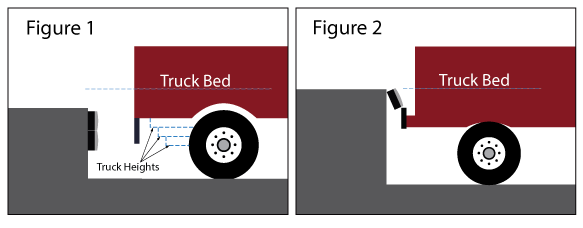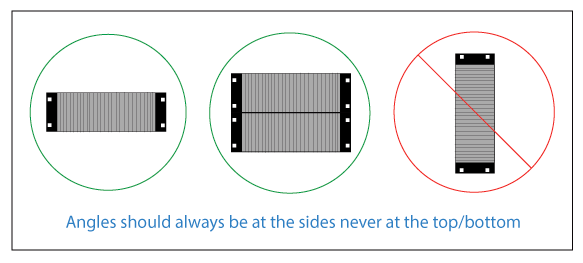Dock Bumper Selection GuideBASIC DOCK BUMPER ARRANGEMENTSFor the most comprehensive dock protection, a combination of vertical and horizontal bumpers, provides the greatest protection for both facilities and trailers. For example, an 8’ wide bay door receiving trucks at a straight approach are best protected by 24” high bumpers on either side and a standard 10” high bumper in the center. This allows a variety of trailer heights to be accommodated without the risk of trailers coming in below the 10” bumper centered in the opening. BASIC DOCK BUMPER INSTALLATION
Note: unfilled Cinder block walls will not work with anchor sleeves Dock Bumper Directory Dock Bumper Thickness The typical projection for a dock bumper is 4.5”. While ideal for a docks with a level approach & no obstructions, loading docks with declines require thicker bumpers to maintain a minimum gap of 4" between the wall and trailer. Increasing Thickness for Decline Approaches Pit Leveler Bumpers
Bumper Heights Dock bumper heights are relative to the recycled tire pads used for manufacturing, typically these come in 6”, 10”, & 12” Heights. While the industry standard dock bumpers are built to this, greater heights are effectively achieved by stacking pads on top of each other. This allows for the production of 20”, 24”, & 36” high bumpers. For best results always choose bumper heights which will best accommodate your traffic and facility. 6” dock bumpers are traditionally used on docks where a lip protrudes from the wall and has a face of 10” or less. 10” dock bumpers are the most widely used for docks where trucks come in at approximately equal heights or when only standard size trucks are received.
DOCK BUMPER INSTALLATIONInstall bumpers (Fig 10) 1" to 2" below dock level. Use 3/4" or 5/8" lag bolts or sleeve anchors; minimum length 3" and use corresponding shield if required. Use 3/4" "J" bolts with a minimum length of 8" with 1 1/4" projection. Note: Never turn your bumper so the angles are on top. Doing so will cause separation of the rubber pads reducing the distance between your angles and the bumper surface, in addition to reducing the bumpers impact rating. For applications requiring taller models we carry standard heights of 6", 10", 12", 20", 24", 36" heights are available.
Special Bumper ApplicationsSteel Face Bumpers Balancing lower impact absorption, while offering greater resistance to up and down friction, steel faced dock bumpers protect your dock from excessive trailer movement. Whether it's due to heavy loads or air ride trailers, extreme shifts in trailer height wear bumpers down long before their expected service life. Overlapping Angles An alternative to extra length bumpers overlapping angles reduce the number of anchors and space between paired dock bumpers (fig 5) Open Docks Open docks without predetermined docking positions, are best suited to a combination of bumper sizes and placements (Fig.3). When using 36” horizontal dock bumpers maximum spacing should be 24” between units with a minimum of 5” on center (Fig.6). Refrigerated Doors (with or without dock shelters) Refrigerated doors generally require a bumper for a complete seal around the truck and dock (Fig. 7). The same applies to doors sealed to maintain temperatures. With shelters, the rubber surface of the bumper must extend under the vertical members of the Shelter pad to complete the seal. Portable Dock Plates Effectively use your dock plate by centering a 36” bumper below the door opening, this allows for simple plate insertion even when a truck is already docked. Allow space for your plate legs and mount vertical bumpers at the desired distances on either side. Adjustable Dock Boards When using 14” hole center, height should be a minimum of 12”. Most boards adequately handle 4.5” & 6” bumper projections without impairing lip penetration into truck opening. Fig 8 shows damage from "short spacing". Fig 9 shows " lateral safety zone" impact absorption advantage provided by longer bumpers.
|
sales@loadingdocksupply.com
Contact Us
1-800-741-1258
Loading Dock Equipment, Loading Dock Ramps, Dock Bumpers, Dock Boards, Yard Ramps, Dock Lights, and Industrial Equipment
Serving OH, AL, AK, AZ, AR, CA, CO, CT, DE, FL, GA, IA, IL, IN, ID, KS, KY, LA, ME, MD, MA, MI, MN, MS, MO, MT, NE, NV, NH, NJ, NM, NY, NC, ND, OK, OR, PA, RI, SC, SD, TN, TX, UT, VT, VA, WA, WV, WI, WY
Loading Dock Equipment





 Note: When measuring slope keep in mind the goal is to measure the slope of the trailer. For the majority of applications this would require a slope measurement from 50'.
Note: When measuring slope keep in mind the goal is to measure the slope of the trailer. For the majority of applications this would require a slope measurement from 50'.













